- Home
- Humana Medicaid
- Kentucky Medicaid
- Medicaid extras
- Health and wellness
- Parents Home
- Para Padres
- A to Z Dictionary
- Allergy Center
- Asthma
- Cancer
- Diabetes
- Diseases & Conditions
- Doctors & Hospitals
- Emotions & Behavior
- First Aid & Safety
- Flu (Influenza)
- Food Allergies
- General Health
- Growth & Development
- Heart Health & Conditions
- Homework Help Center
- Infections
- Newborn Care
- Nutrition & Fitness
- Play & Learn
- Pregnancy Center
- Preventing Premature Birth
- Q&A
- School & Family Life
- Sports Medicine
- Teens Home
- Para Adolescentes
- Asthma
- Be Your Best Self
- Body & Skin Care
- Cancer
- Diabetes
- Diseases & Conditions
- Drugs & Alcohol
- Flu (Influenza)
- Homework Help
- Infections
- Managing Your Weight
- Medical Care 101
- Mental Health
- Nutrition & Fitness
- Q&A
- Safety & First Aid
- School, Jobs, & Friends
- Sexual Health
- Sports Medicine
- Stress & Coping
Kidneys and Urinary Tract
What Are the Kidneys and Urinary Tract?
The urinary tract is one of the systems that our bodies use to get rid of waste products. The kidneys are the part of the urinary tract that makes urine (pee). Urine has salts, toxins, and water that need to be filtered out of the blood. After the kidneys make urine, it leaves the body using the rest of the urinary tract as a pathway.
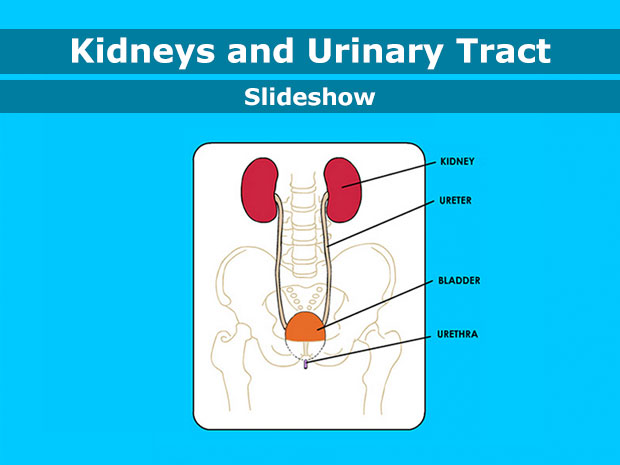
Kidneys and Urinary Tract
The kidneys do a lot, but their most important job is to take waste out of the blood and make urine (pee). The urinary tract takes this waste out of the body when a person pees.
Click through this slideshow to learn more about the kidneys and urinary tract.
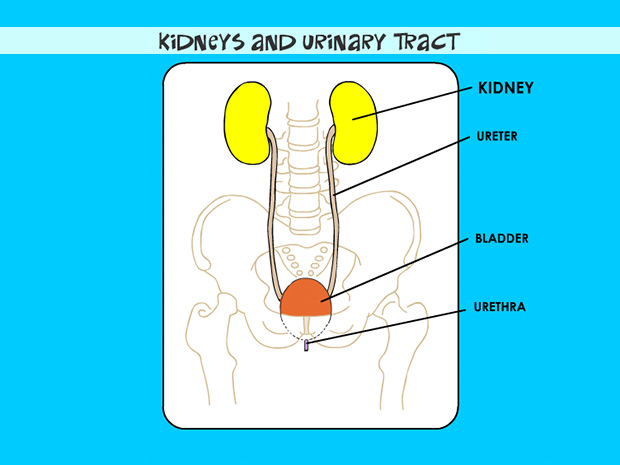
Kidneys and Urinary Tract
Kidneys
The bean-shaped kidneys filter waste products out of the bloodstream and dispose of them by creating urine. Urine is made of these waste products dissolved in water.
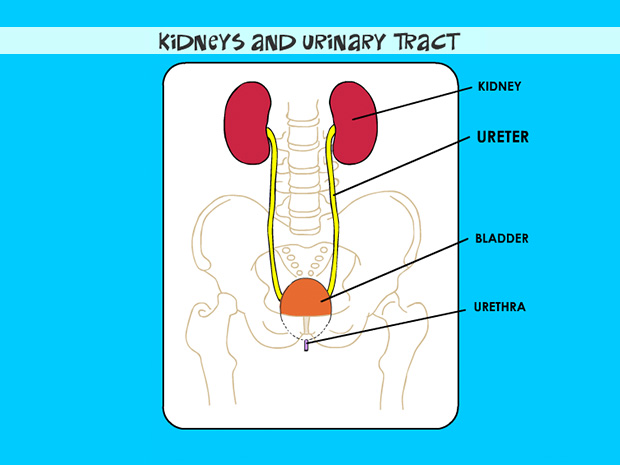
Kidneys and Urinary Tract
Ureter
This thin, tube-like structure carries urine from the kidney to the bladder. There are two ureters - one draining each kidney.
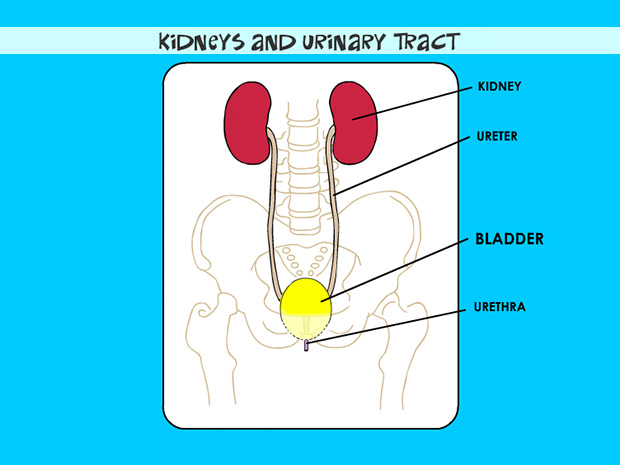
Kidneys and Urinary Tract
Bladder
This expandable, muscular sac in the lower abdomen stores urine until is it passed (voided) from the body through the urethra.
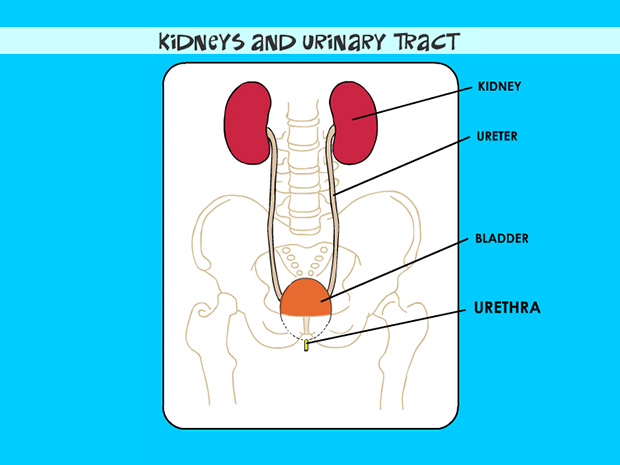
Kidneys and Urinary Tract
Urethra
This single tube-like structure allows urine to exit the body from the bladder.
What Are the Parts of the Urinary Tract?
People usually have two kidneys, but can live a normal, healthy life with just one. The kidneys are under the ribcage in the back, one on each side. Each adult kidney is about the size of a fist.
Each kidney has an outer layer called the cortex, which contains filtering units. The center part of the kidney, the medulla (pronounced: meh-DUH-luh), has fan-shaped structures called pyramids. These drain urine into cup-shaped tubes called calyxes (pronounced: KAY-luh-seez).
From the calyxes, pee travels out of the kidneys through the ureters (pronounced: YUR-uh-ters) to be stored in the bladder (a muscular sac in the lower belly). When a person urinates, the pee exits the bladder and goes out of the body through the urethra (pronounced: yoo-REE-thruh), another tube-like structure. The male urethra ends at the tip of the penis; the female urethra ends just above the vaginal opening.
What Do the Kidneys Do?
Kidneys have many jobs, from filtering blood and making pee to keeping bones healthy and making a hormone that controls the production of red blood cells.
The kidneys also help regulate blood pressure, the level of salts in the blood, and the acid-base balance (the pH) of the blood. All these jobs make the kidneys essential to keeping the body working as it should.
How Do the Kidneys and Urinary Tract Work?
Blood travels to each kidney through the renal artery. The artery enters the kidney at the hilus (pronounced: HY-luss), the indentation in middle of the kidney that gives it its bean shape. The artery then branches so blood can get to the nephrons (pronounced: NEH-fronz) — 1 million tiny filtering units in each kidney that remove the harmful substances from the blood.
Each of the nephrons contain a filter called the glomerulus (pronounced: gluh-MER-yuh-lus). The fluid that is filtered out from the blood then travels down a tiny tube-like structure called a tubule (pronounced: TOO-byool). The tubule adjusts the level of salts, water, and wastes that will leave the body in the urine. Filtered blood leaves the kidney through the renal vein and flows back to the heart.
Pee leaves the kidneys and travels through the ureters to the bladder. The bladder expands as it fills. When the bladder is full, nerve endings in its wall send messages to the brain. When a person needs to pee, the bladder walls tighten and a ring-like muscle that guards the exit from the bladder to the urethra, called the sphincter (pronounced: SFINK-tur), relaxes. This lets pee go into the urethra and out of the body.
What Can Help Keep the Kidneys and Urinary Tract Healthy?
To help keep your kidneys and urinary tract healthy:
- Get plenty of exercise.
- Eat a nutritious diet.
- Stay hydrated.
- For girls: Wipe from front to back after pooping so germs don't get into the urethra.
- Avoid bubble baths, sitting in the tub after shampoo has been used, and scented soaps. These can irritate the urethra.
- Wear cotton underwear.
- Promptly change out of wet bathing suits.
- Go for regular medical checkups.
- Talk to your doctor before taking any supplements or herbal treatments.
- Let the doctor know about any family history of kidney problems, diabetes, or high blood pressure.
- Let the doctor know if you have any swelling or puffiness, have pain with peeing, need to pee often, have foamy urine or blood in the urine, or are constipated.

© 1995- The Nemours Foundation. KidsHealth® is a registered trademark of The Nemours Foundation. All rights reserved.
Images sourced by The Nemours Foundation and Getty Images.